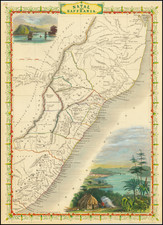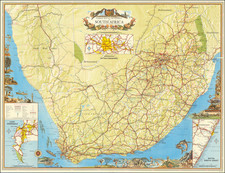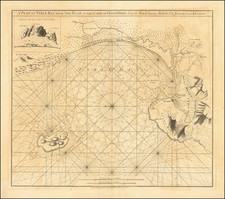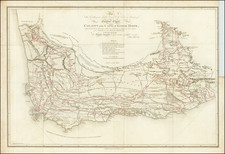Fine mid-18th century hand-drawn composite view and map image of the Cape of Good Hope, showing details of the Dutch Cape Colony, and British and Dutch ships in the harbor.
The view was probably executed by a visiting Frenchman in the 1730s or slightly later, to document an area of fundamental strategic importance. The French long had aspiration for the control of Cape Town, as it was vital to the East Indies trade that was so profitable for their European rivals.
This fine viewsheet comprises four smaller images:
Vue de la Montagne de Table Baye et de la Teste [sic] du Lion du Costé de la Mer [View of Table Mountain Bay and the Lion's Head from the Coast of the Sea]
Vue de la rade et des deux entrée du cap de Bonne Esperence [View of the harbor and the two entrances to the Cape of Good Hope]
Vue du Cap de Bonne Esperence [View of the Cape of Good Hope]
Rade du Cap Bonne Esperence [Harbor of Cape Good Hope]
The plan at the lower right demonstrates routes taken by vessels entering from the north and south, and leaving from the north. It also includes soundings along the coast and around Robben Island.
The coastal profiles are taken from differing vantages and illustrate the coastal topography as witnessed from the sea.
A tiny settlement can be seen at Cape Town, with many individual buildings discernable from the skyline. Several notable landmarks are labeled: Table Mountain, Lion's Head, Lion's Rump (Signal Hill), Robben Island, and Dutch East India Company fortifications and garrisons (Pentagone, i.e., Castle of Good Hope; Batterie - Chavonnes Battery).
Large merchant ships are seen anchored in the harbor, most bearing the Dutch flag and others a British Red Ensign.
Based on views and charts from the first decades of the 18th century (see, for instance, this Thornton chart), Cape Town seems to have grown substantially, pushing the date of creation more into the middle of the 18th century.
Such large and detailed manuscript views of Cape Town are very rare on the market.











![Colton's Africa [Southern Sheet]](https://storage.googleapis.com/raremaps/img/small/98349.jpg)

![[Luanda, Angola] Eroberung der Statt Loando de Sanct Paolo in Angola in Africa. Gelegen](https://storage.googleapis.com/raremaps/img/small/85194.jpg)
